Importance of Public Transport Networks for Reconciling the Spatial Distribution of Dengue and the Association of Socio-Economic Factors with Dengue Risk in Bangkok, Thailand
Abstract
:1. Introduction
2. Materials and Methods
2.1. Study Design
2.2. Study Area
2.3. Data Sources
2.3.1. Dengue Incidence Data
2.3.2. Environmental Data
2.3.3. Socio-Economic Variables
- (1)
- (2)
- Immigration can impose a significant dengue risk due to lack of access to health care or proper housing conditions [31];
- (3)
- Agricultural areas generally have higher rainfall and humidity, lower abundance of Ae. aegypti but higher of Aedes albopictus [32];
- (4)
- Manual work sites such as construction sites are found to be potential areas of dengue clusters [33];
- (5)
- High population density is a known risk factor for dengue transmission [34];
- (6)
- Age will reflect differential exposure to DENV and subsequent level of acquired immunity and thus could be a potential confounder for dengue incidence [31];
- (7)
- (8)
- Shop houses usually have longer hours with windows and doors are open and thus provide easy entrance for mosquitoes [35];
- (9)
- (10)
- (11)
- Air conditioners promote indoor breeding sites and impact survival of Ae. aegypti mosquito through maintenance of clement temperatures;
- (12)
2.3.4. Intra-Urban Transport Networks Variables
2.4. Statistical Methods
2.4.1. Association Analyses
2.4.2. Spatial Analysis
3. Results
3.1. Impact of Meteorological Variables on the Dengue Incidence in Bangkok 2000–2013
3.2. Association of Socio-Economic Factors with Dengue Incidence
3.3. Spatial Analysis of Dengue Incidence
3.4. Impact of Transport and Distance
4. Discussion
5. Conclusions
Author Contributions
Funding
Institutional Review Board Statement
Informed Consent Statement
Data Availability Statement
Acknowledgments
Conflicts of Interest
Appendix A
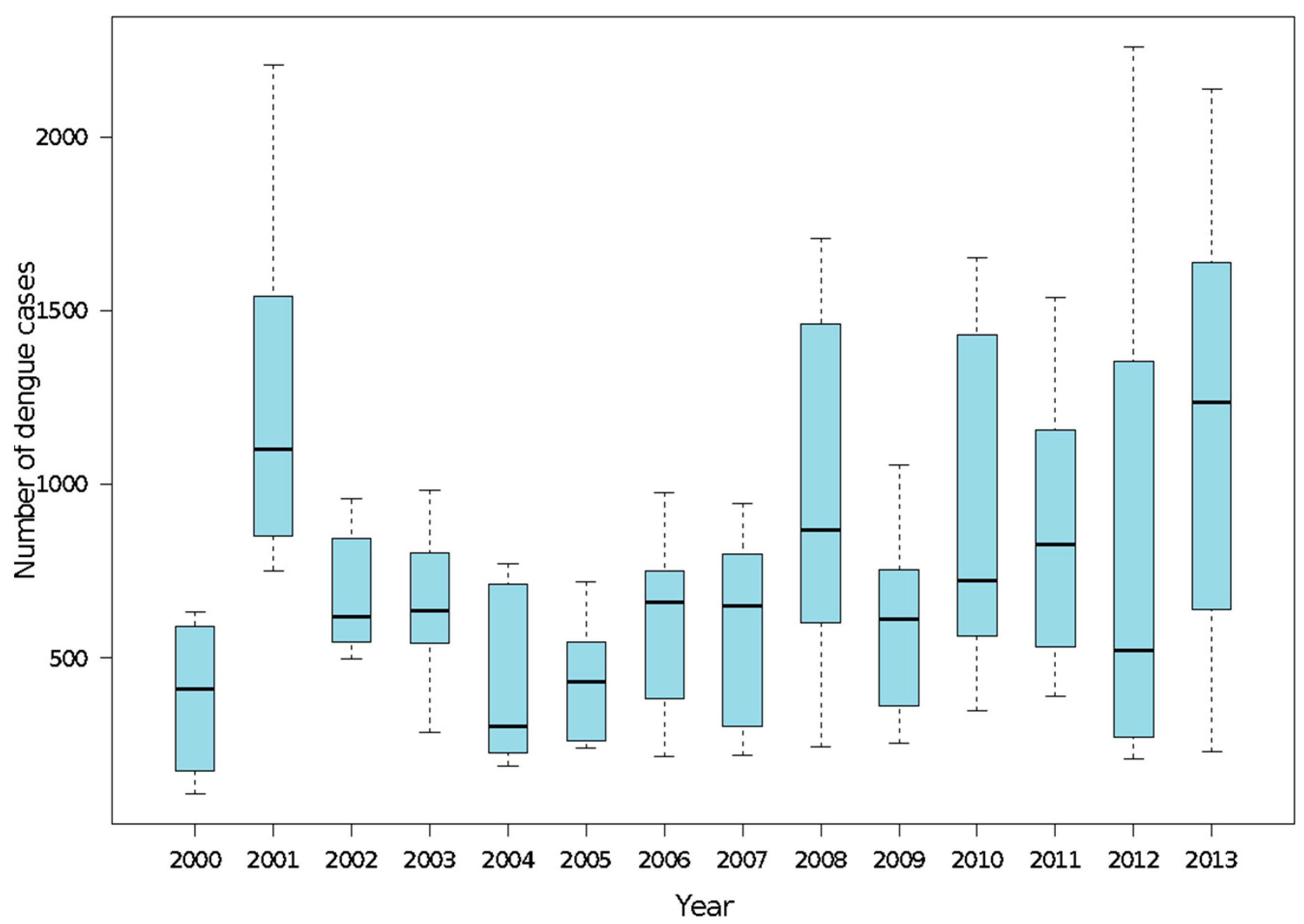
| Definition (as Per NSO and Own Analysis) | Referred to as |
|---|---|
| Demography | |
| Proportion of population aged 0–4 years | Age 0–4 years |
| Proportion of population aged 5–14 years | Age 5–14 years |
| Proportion of population aged 15–24 years | Age 15–24 years |
| Proportion of population aged 25–59 years | Age 25–59 years |
| Proportion of population aged 60 years and above | Age above 60 |
| Number of households (100s) | Number of households |
| Total subdistrict area in km2 | Area |
| % Area Built-up in km2 | Built-up area |
| % Area with dense vegetation in km2 | Dense vegetation area |
| % Area with low vegetation in km2 | Low vegetation area |
| % Area with Roads in km2 | Road area |
| % Area with water bodies in km2 | Waterbody area |
| Population per household | Population per household |
| Population density in km2 | Population density |
| Education | |
| Proportion of population aged 6 years and above who never studied | No education |
| Proportion of population attending Primary school | Primary |
| Proportion of population attending Secondary school | Secondary |
| Proportion of population attending Undergraduate | Undergraduate |
| Proportion of population attending Postgraduate | Postgraduate |
| Nationality | |
| Proportion of migrant population (abroad and Thai) who moved in last 5 years | Immigrants |
| Types of occupation | |
| Proportion of population engaged in agriculture, forest and fishing work | Agriculture |
| Proportion of population involved in manual, construction, mining and network work | Manual work |
| Household characteristics | |
| Proportion of houses made up of cement or brick | Cement or brick houses |
| Proportion of wooden houses | Wooden houses |
| Proportion of households using ground water, well water | Ground water |
| Proportion of households using rain water | Rain water |
| Proportion of households with air conditioner | Air conditioner |
| Proportion of shop house/row house/row homes | Shop houses |
| Proportion of households with pit toilet or who defecate into river/canal | Pit toilet |
| Models | Meteorological Variables | R2 |
|---|---|---|
| Model 1 | Mean Diurnal temperature Range +Year | 22.09 |
| Model 2 | Lag 1_Mean Diurnal temperature Range + Year | 28.56 |
| Model 3 | Lag 2_Mean Diurnal temperature Range + Year | 21.17 |
| Model 4 | Lag 3_Mean Diurnal temperature Range + Year | 13.01 |
| Model 5 | Max temperature + Year | 11.71 |
| Model 6 | Lag 1_max temperature + Year | 9.06 |
| Model 7 | Lag 2_max temperature + Year | 4.90 |
| Model 8 | Lag 3_max temperature + Year | 9.86 |
| Model 9 | Min temperature + Year | 6.01 |
| Model 10 | Lag 1_min temperature + Year | 7.73 |
| Model 11 | Lag 2_min temperature + Year | 13.21 |
| Model 12 | Lag 3_ min temperature + Year | 21.19 |
| Model 13 | Mean precipitation + Year | 8.45 |
| Model 14 | Lag 1_ Mean precipitation + Year | 17.38 |
| Model 15 | Lag 2_ Mean precipitation + Year | 16.66 |
| Model 16 | Lag 3_ Mean precipitation + Year | 8.66 |
| Model 17 | Max precipitation + Year | 3.2 |
| Model 18 | Lag 1_Max precipitation + Year | 8.26 |
| Model 19 | Lag 2_Max precipitation + Year | 8.14 |
| Model 20 | Lag 3_Max precipitation + Year | 5.029 |
| Model 21 | Mean temperature + Year | 6.68 |
| Model 22 | Lag 1_mean temperature + Year | 5.37 |
| Model 23 | Lag 2_mean temperature + Year | 7.82 |
| Model 24 | Lag 3_mean temperature + Year | 16.34 |

| Variable | Dry Season | Wet Season | Combined |
|---|---|---|---|
| Year | <0.001 | <0.001 | <0.001 |
| Agriculture, Forest & fishing | 0.022 | 0.005 | 0.006 |
| No education | 0.068 | 0.087 | 0.07 |
| Primary | 0.303 | 0.244 | 0.262 |
| Secondary | 0.221 | 0.274 | 0.252 |
| Undergraduate | 0.721 | 0.436 | 0.510 |
| Postgraduate | 0.991 | 0.967 | 0.984 |
| Migrant Population | 0.165 | 0.024 | 0.04 |
| Shop house | 0.009 | 0.006 | 0.005 |
| House: Cement or brick | <0.001 | <0.001 | <0.001 |
| House: Wood | <0.001 | <0.001 | <0.001 |
| Air conditioning | 0.472 | 0.670 | 0.926 |
| Groundwater, well | 0.071 | 0.193 | 0.126 |
| Pit toilet | 0.636 | 0.261 | 0.353 |
| Rain water | 0.045 | 0.013 | 0.014 |
| Number of households | <0.001 | <0.001 | <0.001 |
| Manual | 0.005 | 0.037 | 0.016 |
| Population density | 0.301 | 0.822 | 0.682 |
| Age 0–4 years | 0.716 | 0.834 | 0.754 |
| Age 5–14 years | 0.267 | 0.077 | 0.099 |
| Age 15–24 years | 0.147 | 0.126 | 0.122 |
| Age 25–59 | 0.039 | 0.002 | 0.003 |
| Age 60+ | <0.001 | <0.001 | <0.001 |
| Pop per house | 0.089 | 0.032 | 0.033 |
| Dense vegetation/km2 | 0.726 | 0.526 | 0.725 |
| Low vegetation/km2 | 0.144 | 0.354 | 0.253 |
| Road area/km2 | <0.001 | <0.001 | <0.001 |
| Waterbody area/km2 | 0.349 | 0.260 | 0.262 |
| Built-up area/km2 | <0.001 | <0.001 | <0.001 |
| Season | Fixed Term | aRR | 95% CI Lower | 95% CI Upper | p Value |
|---|---|---|---|---|---|
| Wet | % No education | 1.048 | 1.016 | 1.082 | 0.004 |
| Wet | % Cement houses | 1.007 | 1.003 | 1.011 | 0.006 |
| Dry | %Ground water | 0.456 | 0.220 | 0.946 | 0.036 |
| Dry | %Manual work | 1.008 | 1.002 | 1.014 | 0.018 |
| Wet | Nb houses (100s) | 1.0019 | 1.0015 | 1.0023 | <0.001 |
| Dry | Nb houses (100s) | 1.0016 | 1.0012 | 1.0020 | <0.001 |
| Wet | lag 1 DTR | 0.835 | 0.757 | 0.921 | <0.001 |
| Wet | lag 1 Mean monthly Rain | 1.016 | 1.012 | 1.020 | <0.001 |
| Variables | Cluster | 2012 | 2013 | ||||
|---|---|---|---|---|---|---|---|
| Parameter Estimate | p Value | % Var Explained | Parameter Estimate | p Value | % Var Explained | ||
| % No education | High–High | 1.265 | 0.023 | 7.80% | 9.596 | <0.001 | 67.70% |
| Low–Low | −1.248 | <0.001 | −1.453 | 0.015 | |||
| Low–High | −0.22 | 0.866 | 1.92 | 0.137 | |||
| High–Low | NA | −7.66 | <0.001 | ||||
| No cluster | Ref | Ref | |||||
| %Cement house | High–High | 5.66 | 0.003 | 15.80% | −2.41 | 0.365 | 3.70% |
| Low–Low | −1.22 | 0.31 | 5.98 | 0.007 | |||
| Low–High | 21.34 | <0.001 | −5.26 | 0.271 | |||
| High–Low | NA | 2.82 | 0.632 | ||||
| No cluster | Ref | Ref | |||||
| Nb houses (100s) | High–High | −69.3 | 0.188 | 6.60% | −409.1 | <0.001 | 30.80% |
| Low–Low | 107.9 | 0.002 | −81.9 | 0.105 | |||
| Low–High | 165 | 0.176 | −47 | 0.668 | |||
| High–Low | NA | 184 | 0.176 | ||||
| No cluster | Ref | Ref | |||||
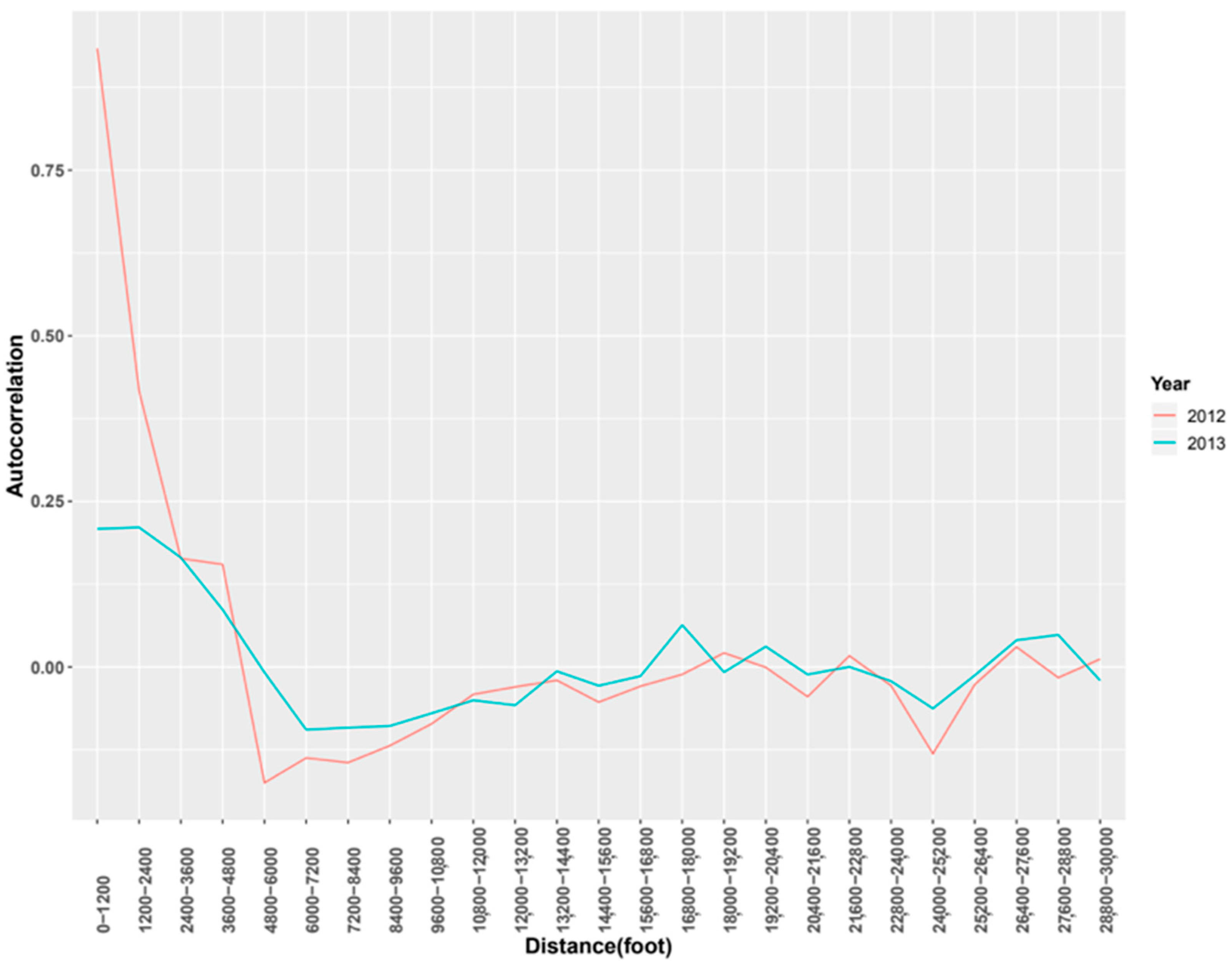
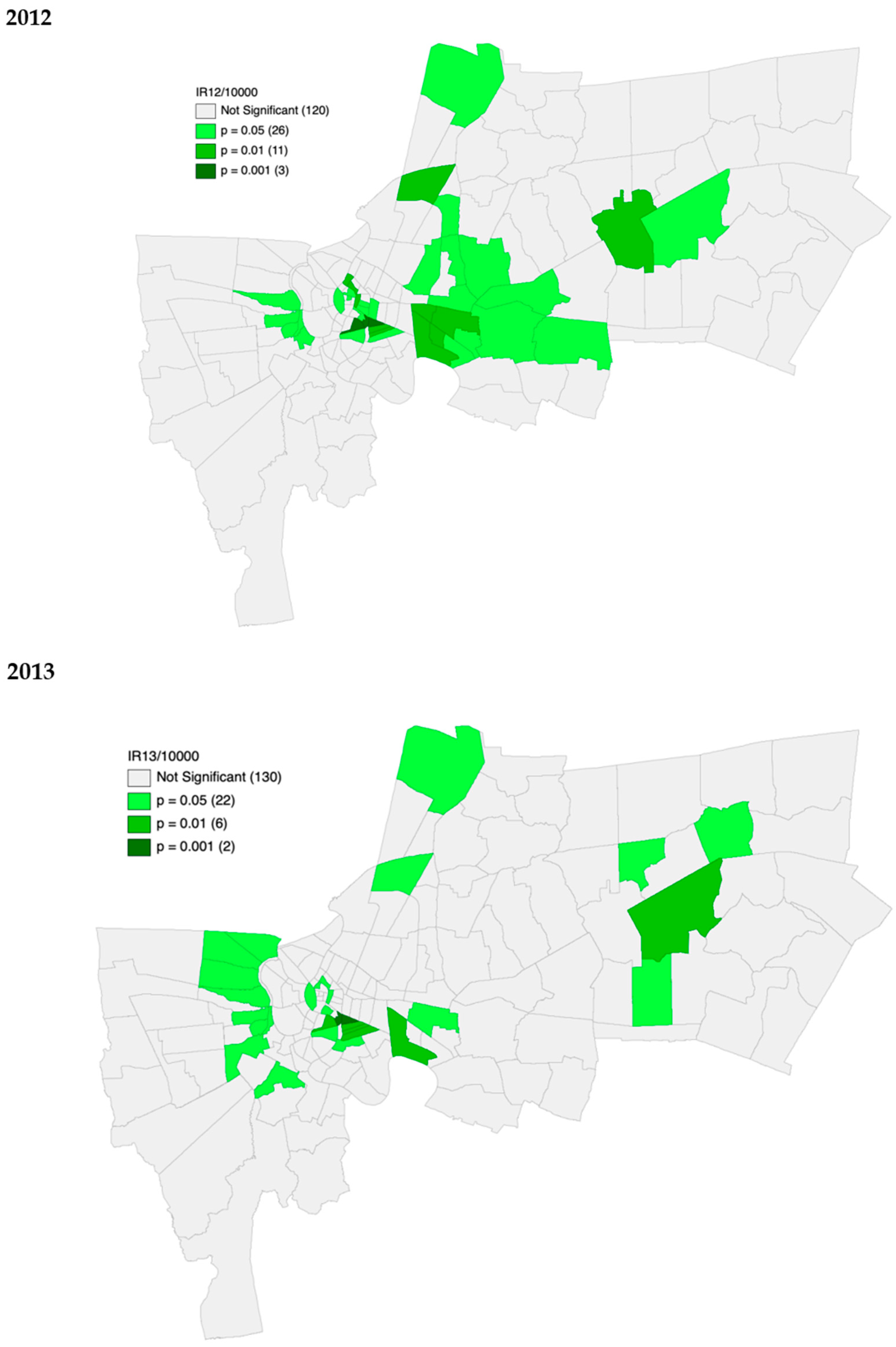
References
- WHO. Dengue and Dengue Hemorrhagic Fever, Fact Sheet 117; Revised February 2015; World Health Organization: Geneva, Switzerland, 2012; Available online: http://www.who.int/mediacentre/factsheets/fs117/en/ (accessed on 5 March 2019).
- Guzman, M.G.; Halstead, S.B.; Artsob, H.; Buchy, P.; Farrar, J.; Gubler, D.J.; Hunsperger, E.; Kroeger, A.; Margolis, H.S.; Martínez, E.; et al. Dengue: A continuing global threat. Nat. Rev. Microbiol. 2010, 8, S7–S16. [Google Scholar] [CrossRef] [PubMed]
- Daudé, É.; Mazumdar, S.; Solanki, V. Widespread Fear of Dengue Transmission but Poor Practices of Dengue Prevention: A Study in the Slums of Delhi, India. PLoS ONE 2017, 12, e0171543. [Google Scholar] [CrossRef] [PubMed]
- Bhatt, S.; Gething, P.W.; Brady, O.J.; Messina, J.P.; Farlow, A.W.; Moyes, C.L.; Drake, J.M.; Brownstein, J.S.; Hoen, A.G.; Sankoh, O.; et al. The global distribution and burden of dengue. Nature 2013, 496, 504–507. [Google Scholar] [CrossRef] [PubMed]
- Gubler, D.J. Epidemic dengue/dengue hemorrhagic fever as a public health, social and economic problem in the 21st century. Trends Microbiol. 2002, 10, 100–103. [Google Scholar] [CrossRef]
- Kyle, J.L.; Harris, E. Global Spread and Persistence of Dengue. Annu. Rev. Microbiol. 2008, 62, 71–92. [Google Scholar] [CrossRef]
- Hii, Y.L.; Zhu, H.; Ng, N.; Ng, L.C.; Rocklöv, J. Forecast of Dengue Incidence Using Temperature and Rainfall. PLoS Negl. Trop. Dis. 2012, 6, e1908. [Google Scholar] [CrossRef]
- Paul, R.; Sousa, C.A.; Sakuntabhai, A.; Devine, G. Mosquito control might not bolster imperfect dengue vaccines. Lancet 2014, 384, 1747–1748. [Google Scholar] [CrossRef]
- Liu-Helmersson, J.; Stenlund, H.; Wilder-Smith, A.; Rocklöv, J. Vectorial capacity of Aedes aegypti: Effects of temperature and implications for global dengue epidemic potential. PLoS ONE 2014, 9, e89783. [Google Scholar] [CrossRef]
- Lowe, R.; Cazelles, B.; Paul, R.; Rodó, X. Quantifying the added value of climate information in a spatio-temporal dengue model. Stoch. Environ. Res. Risk Assess. 2016, 30, 2067–2078. [Google Scholar] [CrossRef]
- Misslin, R.; Telle, O.; Daudé, E.; Vaguet, A.; Paul, R.E. Urban climate versus global climate change-what makes the difference for dengue? Climate, dengue, and urban heat islands. Ann. N. Y. Acad. Sci. 2016, 1382, 56–72. [Google Scholar] [CrossRef]
- Misslin, R.; Daudé, É. An environmental suitability index based on the ecological constraints of Aedes aegypti, vector of dengue and Zika virus. Rev. Int. Géomatique Int. Rev. Geomat. 2017, 27, 481–501. [Google Scholar] [CrossRef]
- Telle, O.; Vaguet, A.; Yadav, N.K.; Lefebvre, B.; Daudé, E.; Paul, R.E.; Cebeillac, A.; Nagpal, B.N. The Spread of Dengue in an Endemic Urban Milieu—The Case of Delhi, India. PLoS ONE 2016, 11, e0146539. [Google Scholar] [CrossRef]
- Nagao, Y.; Thavara, U.; Chitnumsup, P.; Tawatsin, A.; Chansang, C.; Campbell-Lendrum, D. Climatic and social risk factors for Aedes infestation in rural Thailand. Trop. Med. Int. Health 2003, 8, 650–659. [Google Scholar] [CrossRef]
- Tipayamongkholgul, M.; Lisakulruk, S. Socio-geographical factors in vulnerability to dengue in Thai villages: A spatial regression analysis. Geospat. Health 2011, 5, 191–198. [Google Scholar] [CrossRef]
- Kikuti, M.; Cunha, G.M.; Paploski, I.; Kasper, A.M.; Silva, M.M.O.; Tavares, A.S.; Cruz, J.S.; Queiroz, T.L.; Rodrigues, M.S.; Santana, P.M.; et al. Spatial Distribution of Dengue in a Brazilian Urban Slum Setting: Role of Socioeconomic Gradient in Disease Risk. PLoS Negl. Trop. Dis. 2015, 9, e0003937. [Google Scholar] [CrossRef]
- Zellweger, R.M.; Cano, J.; Mangeas, M.; Taglioni, F.; Mercier, A.; Despinoy, M.; Menkes, C.; Dupont-Rouzeyrol, M.; Nikolay, B.; Teurlai, M. Socioeconomic and environmental determinants of dengue transmission in an urban setting: An ecological study in Nouméa, New Caledonia. PLoS Negl. Trop. Dis. 2017, 11, e0005471. [Google Scholar] [CrossRef]
- Farinelli, E.C.; Baquero, O.S.; Stephan, C.; Chiaravalloti-Neto, F. Low socioeconomic condition and the risk of dengue fever: A direct relationship. Acta Trop. 2018, 180, 47–57. [Google Scholar] [CrossRef]
- Jain, R.; Sontisirikit, S.; Iamsirithaworn, S.; Prendinger, H. Prediction of dengue outbreaks based on disease surveillance, meteorological and socio-economic data. BMC Infect. Dis. 2019, 19, 272. [Google Scholar] [CrossRef] [PubMed]
- Teixeira, M.D.; Barreto, M.L.; Costa, M.D.; Ferreira, L.D.; Morato, V. Exposure to the risk of dengue virus infection in an urban setting: Ecological vs. individual infection. Dengue Bull. 2007, 31, 36–46. [Google Scholar]
- Stewart-Ibarra, A.M.; Muñoz, A.G.; Ryan, S.J.; Ayala, E.B.; Borbor-Cordova, M.J.; Finkelstein, J.L.; Mejía, R.; Ordoñez, T.; Recalde-Coronel, G.C.; Rivero, K. Spatiotemporal clustering, climate periodicity, and social-ecological risk factors for dengue during an outbreak in Machala, Ecuador, in 2010. BMC Infect. Dis. 2014, 14, 610. [Google Scholar] [CrossRef]
- Mondini, A.; Chiaravalloti-Neto, F. Spatial correlation of incidence of dengue with socioeconomic, demographic and environmental variables in a Brazilian city. Sci. Total Environ. 2008, 393, 241–248. [Google Scholar] [CrossRef] [PubMed]
- Stoddard, S.T.; Morrison, A.C.; Vazquez-Prokopec, G.M.; Soldan, V.P.; Kochel, T.J.; Kitron, U.; Elder, J.P.; Scott, T.W. The role of human movement in the transmission of vector-borne pathogens. PLoS Negl. Trop. Dis. 2009, 3, e481. [Google Scholar] [CrossRef]
- Stoddard, S.T.; Forshey, B.M.; Morrison, A.C.; Paz-Soldan, V.A.; Vazquez-Prokopec, G.M.; Astete, H.; Jeiner, R.C., Jr.; Vilcarromero, S.; Elder, J.P.; Halsey, E.S.; et al. House-to-house human movement drives dengue virus transmission. Proc. Natl. Acad. Sci. USA 2013, 110, 994–999. [Google Scholar] [CrossRef] [PubMed]
- Kenneson, A.; Beltran-Ayala, E.; Borbor-Cordova, M.J.; Polhemus, M.E.; Ryan, S.J.; Endy, T.P.; Stewart-Ibarra, A.M. Social-ecological factors and preventive actions decrease the risk of dengue infection at the household-level: Results from a prospective dengue surveillance study in Machala, Ecuador. PLoS Negl. Trop. Dis. 2017, 11, e0006150. [Google Scholar] [CrossRef] [PubMed]
- Nagao, Y.; Svasti, P.; Tawatsin, A.; Thavara, U. Geographical structure of dengue transmission and its determinants in Thailand. Epidemiol. Infect. 2008, 136, 843–851. [Google Scholar] [CrossRef] [PubMed]
- Srichan, P.; Niyom, S.L.; Pacheun, O.; Iamsirithawon, S.; Chatchen, S.; Jones, C.; White, L.; Pan-Ngum, W. Addressing challenges faced by insecticide spraying for the control of dengue fever in Bangkok, Thailand: A qualitative approach. Int. Health 2018, 10, 349–355. [Google Scholar] [CrossRef]
- National Statistical Organization. The 2010 Population and Housing Census. Available online: https://web.nso.go.th/en/census/poph/2010/cen_poph_10_bkk.htm (accessed on 1 June 2016).
- Jaenisch, T.; IDAMS; Sakuntabhai, A.; DENFREE; Wilder-Smith, A.; DengueTools. Dengue research funded by the European Commission-scientific strategies of three European dengue research consortia. PLoS Negl. Trop. Dis. 2013, 7, e2320. [Google Scholar] [CrossRef]
- Lambrechts, L.; Paaijmans, K.P.; Fansiri, T.; Carrington, L.B.; Kramer, L.D.; Thomas, M.B.; Scott, T.W. Impact of daily temperature fluctuations on dengue virus transmission by Aedes aegypti. Proc. Natl. Acad. Sci. USA 2011, 108, 7460–7465. [Google Scholar] [CrossRef]
- Karczewska-Gibert, A.M. Socio-Economic and Demographic Aspects of Dengue Epidemiology Evolution in Thailand, 1982–2012. Master’s Thesis, University of Barcelona, Barcelona, Spain, 2014. Available online: https://pdfs.semanticscholar.org/7671/334e6324cf56cf7f380a1fd68a13ec8dbaa4.pdf (accessed on 30 June 2016).
- Thongsripong, P.; Green, A.; Kittayapong, P.; Kapan, D.; Wilcox, B.; Bennett, S. Mosquito Vector Diversity across Habitats in Central Thailand Endemic for Dengue and Other Arthropod-Borne Diseases. PLoS Negl. Trop. Dis. 2013, 7, e2507. [Google Scholar] [CrossRef]
- Liang, S.; Hapuarachchi, H.C.; Rajarethinam, J.; Koo, C.; Tang, C.-S.; Chong, C.-S.; Ng, L.-C.; Yap, G.; Hapuarachchi, H.C. Construction sites as an important driver of dengue transmission: Implications for disease control. BMC Infect. Dis. 2018, 18, 382. [Google Scholar] [CrossRef]
- Qu, Y.; Shi, X.; Wang, Y.; Li, R.; Lu, L.; Liu, Q. Effects of socio-economic and environmental factors on the spatial heterogeneity of dengue fever investigated at a fine scale. Geospat. Health 2018, 13, 287. [Google Scholar] [CrossRef] [PubMed]
- Thammapalo, S.; Chongsuwiwatwong, V.; Geater, A.; Dueravee, M. Environmental factors and incidence of dengue fever and dengue haemorrhagic fever in an urban area, Southern Thailand. Epidemiol. Infect. 2008, 136, 135–143. [Google Scholar] [CrossRef] [PubMed]
- Sampaio, A.M.; Kligerman, D.C.; Júnior, S.F. Dengue, related to rubble and building construction in Brazil. Waste Manag. 2009, 29, 2867–2873. [Google Scholar] [CrossRef] [PubMed]
- WHO. Eco-Bio-Social Determinants of Dengue Vector Breeding: A Multicountry Study in Urban and Periurban Asia. (n.d.); Retrieved 9 June 2019; WHO: Geneva, Switzerland, 2019; Available online: https://www.who.int/bulletin/volumes/88/3/09-067892/en/ (accessed on 14 June 2020).
- Kumar, V.; Pande, V.; Srivastava, A.; Gupta, S.K.; Singh, V.P.; Singh, H.; Saxena, R.; Tuli, N.R.; Yadav, N.K.; Paul, R.; et al. Comparison of Ae. aegypti breeding in localities of different socio-economic groups of Delhi, India. Int. J. Mosq. Res. 2015, 2, 83–88. [Google Scholar]
- Dieng, H.; Saifur, R.G.; Ahmad, A.H.; Salmah, C.; Aziz, A.T.; Satho, T.; Miake, F.; Jaal, Z.; Abubakar, S.; Morales, R.E. Unusual developing sites of dengue vectors and potential epidemiological implications. Asian Pac. J. Trop. Biomed. 2012, 2, 228–232. [Google Scholar] [CrossRef]
- Toan, D.T.T.; Hoat, L.N.; Hu, W.; Wright, P.; Martens, P. Risk factors associated with an outbreak of dengue fever/dengue haemorrhagic fever in Hanoi, Vietnam. Epidemiol. Infect. 2015, 143, 1594–1598. [Google Scholar] [CrossRef]
- Sanna, M.; Hsieh, Y.H. Ascertaining the impact of public rapid transit system on spread of dengue in urban settings. Sci. Total Environ. 2017, 598, 1151–1159. [Google Scholar] [CrossRef]
- Gower, J.C. A General Coefficient of Similarity and Some of Its Properties. Biometrics 1971, 27, 857–871. [Google Scholar] [CrossRef]
- Gower, J.C.; Legendre, P. Metric and Euclidean properties of dissimilarity coefficients. J. Classif. 1986, 3, 5–48. [Google Scholar] [CrossRef]
- VSN International Ltd. GenStat for Windows, 15th ed.; VSN International Ltd.: Hemel Hempstead, UK, 2018. [Google Scholar]
- Anselin, L.; Syabri, I.; Kho, Y. GeoDa: An Introduction to Spatial Data Analysis. Geogr. Anal. 2006, 38, 5–22. [Google Scholar] [CrossRef]
- QGIS Development Team. QGIS Geographic Information System. Open Source Geospatial Foundation Project. 2018. Available online: http://qgis.osgeo.org (accessed on 10 April 2019).
- Naish, S.; Dale, P.; Mackenzie, J.S.; McBride, J.; Mengersen, K.; Tong, S. Climate change and dengue: A critical and systematic review of quantitative modelling approaches. BMC Infect. Dis. 2014, 14, 167. [Google Scholar] [CrossRef] [PubMed]
- Padmanabha, H.; Soto, E.; Mosquera, M.; Lord, C.C.; Lounibos, L.P. Ecological links between water storage behaviors and Aedes aegypti production: Implications for dengue vector control in variable climates. Ecohealth 2010, 7, 78–90. [Google Scholar] [CrossRef] [PubMed]
- Vikram, K.; Nagpal, B.; Pande, V.; Srivastava, A.; Saxena, R.; Anvikar, A.; Das, A.; Singh, H.; Anushrita; Gupta, S.K.; et al. An epidemiological study of Dengue in Delhi, India. Acta Trop. 2016, 153, 21–27. [Google Scholar] [CrossRef] [PubMed]
- Mulligan, K.; Dixon, J.; Sinn, C.-L.J.; Elliott, S.J. Is dengue a disease of poverty? A systematic review. Pathog. Glob. Health 2015, 109, 10–18. [Google Scholar] [CrossRef]
- Romeo-Aznar, V.; Paul, R.; Telle, O.; Pascual, M. Mosquito-borne transmission in urban landscapes: The missing link between vector abundance and human density. Proc. Biol. Sci. 2018, 285, 20180826. [Google Scholar] [CrossRef]
- Carrington, L.B.; Seifert, S.N.; Willits, N.H.; Lambrechts, L.; Scott, T.W. Large Diurnal Temperature Fluctuations Negatively Influence Aedes aegypti (Diptera: Culicidae) Life-History Traits. J. Med. Entomol. 2013, 50, 43–51. [Google Scholar] [CrossRef]
- Mammen, M.P.; Pimgate, C.; Koenraadt, C.J.; Rothman, A.L.; Aldstadt, J.; Nisalak, A.; Jarman, R.G.; Jones, J.W.; Srikiatkhachorn, A.; Ypil-Butac, C.A.; et al. Spatial and temporal clustering of dengue virus transmission in Thai villages. PLoS Med. 2008, 5, e205. [Google Scholar] [CrossRef]
- Salje, H.; Lessler, J.; Endy, T.P.; Curriero, F.C.; Gibbons, R.V.; Nisalak, A.; Nimmannitya, S.; Kalayanarooj, S.; Jarman, R.G.; Thomas, S.J.; et al. Revealing the microscale spatial signature of dengue transmission and immunity in an urban population. Proc. Natl. Acad. Sci. USA 2012, 109, 9535–9538. [Google Scholar] [CrossRef]
- Grange, L.; Simon-Loriere, E.; Sakuntabhai, A.; Gresh, L.; Paul, R.; Harris, E. Epidemiological risk factors associated with high global frequency of inapparent dengue virus infections. Front. Immunol. 2014, 5, 280. [Google Scholar] [CrossRef]
- Cebeillac, A.; Daudé, E.; Huraux, T. Where? When? And How Often? What Can We Learn About Daily Urban Mobilities from Twitter Data and Google POIs in Bangkok (Thailand) and Which Perspectives for Dengue Studies? Netcom. Réseaux Commun. Territ. 2017, 31-3/4, 283–308. [Google Scholar] [CrossRef]
- Massaro, E.; Kondor, D.; Ratti, C. Assessing the interplay between human mobility and mosquito borne diseases in urban environments. Sci. Rep. 2019, 9, 16911. [Google Scholar] [CrossRef] [PubMed]
- Banu, S.; Hu, W.; Hurst, C.; Tong, S. Dengue transmission in the Asia-Pacific region: Impact of climate change and socio-environmental factors. Trop. Med. Int. Health 2011, 16, 598–607. [Google Scholar] [CrossRef] [PubMed]
- Akter, R.; Hu, W.; Naish, S.; Banu, S.; Tong, S. Joint effects of climate variability and socioecological factors on dengue transmission: Epidemiological evidence. Trop. Med. Int. Health 2017, 22, 656–669. [Google Scholar] [CrossRef]
- Morato, D.G.; Barreto, F.R.; Braga, J.U.; Natividade, M.S.; Costa, M.D.C.N.; Morato, V.; Teixeira, M.D.G.L.C. The spatiotemporal trajectory of a dengue epidemic in a medium-sized city. Mem. Inst. Oswaldo Cruz 2015, 110, 528–533. [Google Scholar] [CrossRef] [PubMed]
- Cuong, H.Q.; Vu, N.T.; Cazelles, B.; Boni, M.F.; Thai, K.T.; Rabaa, M.A.; Quang, L.C.; Simmons, C.P.; Huu, T.N.; Anders, K.L. Spatiotemporal dynamics of dengue epidemics, southern Vietnam. Emerg. Infect. Dis. 2013, 19, 945–953. [Google Scholar] [CrossRef] [PubMed]
- Vazquez-Prokopec, G.M.; Kitron, U.; Montgomery, B.; Horne, P.; Ritchie, S.A. Quantifying the spatial dimension of dengue virus epidemic spread within a tropical urban environment. PLoS Negl. Trop. Dis. 2010, 4, e920. [Google Scholar] [CrossRef] [PubMed]
- Teurlai, M.; Huy, R.; Cazelles, B.; Duboz, R.; Baehr, C.; Vong, S. Can human movements explain heterogeneous propagation of dengue fever in Cambodia? PLoS Negl. Trop. Dis. 2012, 6, e1957. [Google Scholar] [CrossRef]
- Salje, H.; Lessler, J.; Berry, I.M.; Melendrez, M.C.; Endy, T.; Kalayanarooj, S.; A-Nuegoonpipat, A.; Chanama, S.; Sangkijporn, S.; Klungthong, C.; et al. Dengue diversity across spatial and temporal scales: Local structure and the effect of host population size. Science 2017, 355, 1302–1306. [Google Scholar] [CrossRef]
- Schaber, K.L.; Paz-Soldan, V.; Morrison, A.C.; Elson, W.; Rothman, A.L.; Mores, C.N.; Astete-Vega, H.; Scott, T.W.; Waller, L.A.; Kitron, U.; et al. Dengue illness impacts daily human mobility patterns in Iquitos, Peru. PLoS Negl. Trop. Dis. 2019, 13, e0007756. [Google Scholar] [CrossRef]
- Shragai, T.; Pérez-Pérez, J.; del Pilar Quimbayo-Forero, M.; Rojo, R.; Harrington, L.C.; Rúa-Uribe, G. Distance to public transit predicts spatial distribution of dengue virus incidence in Medellín, Colombia. Sci. Rep. 2022, 12, 8333. [Google Scholar] [CrossRef]
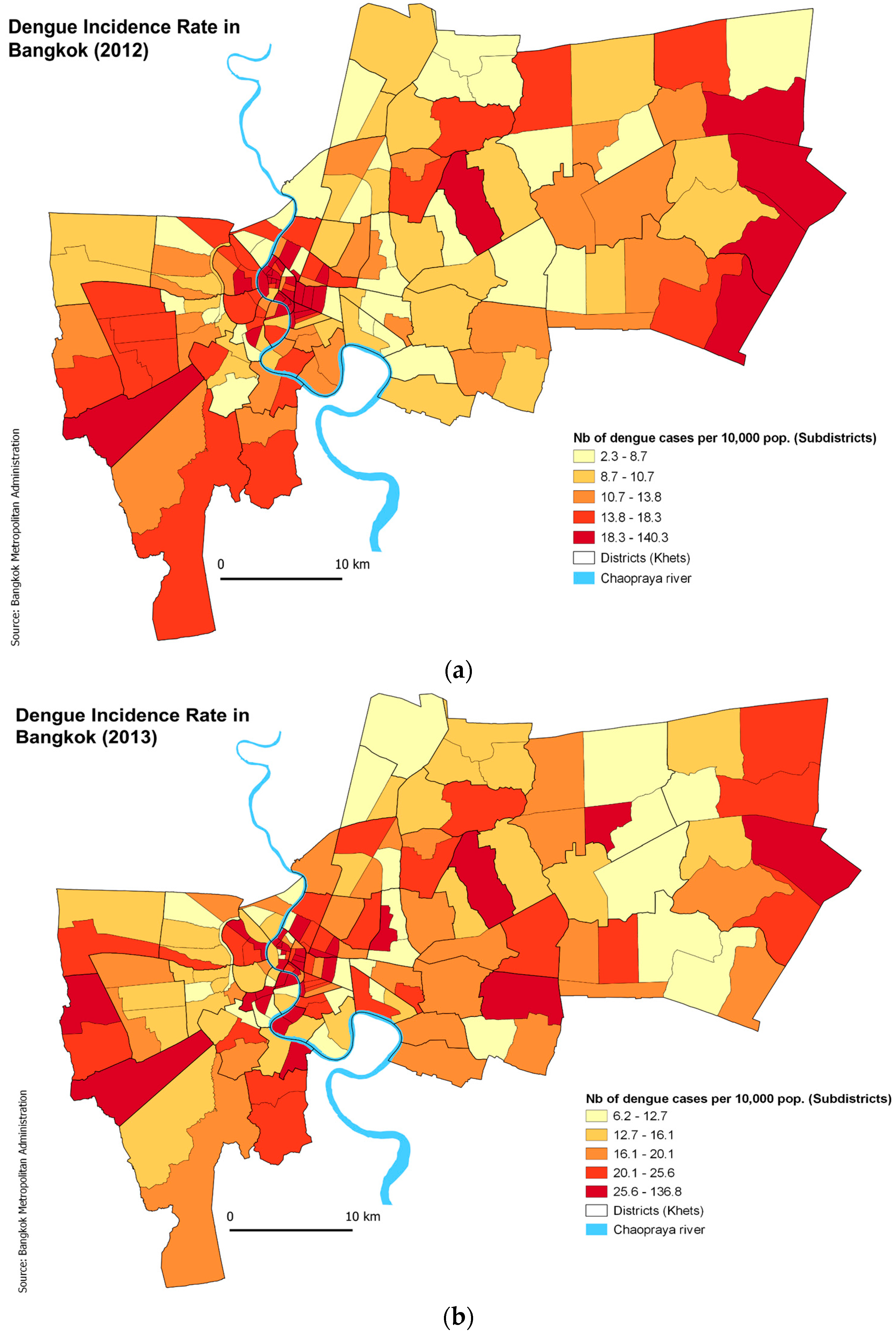
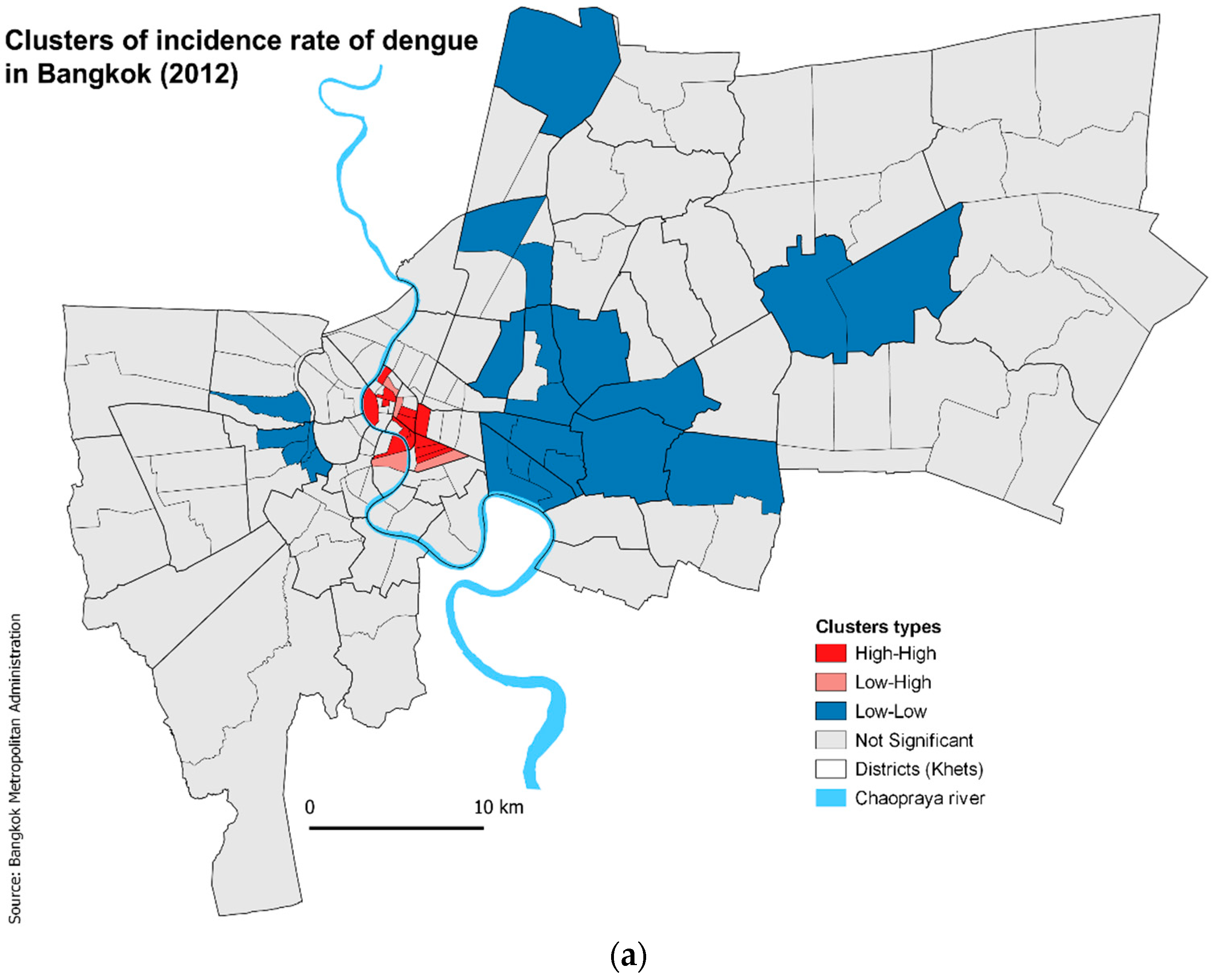
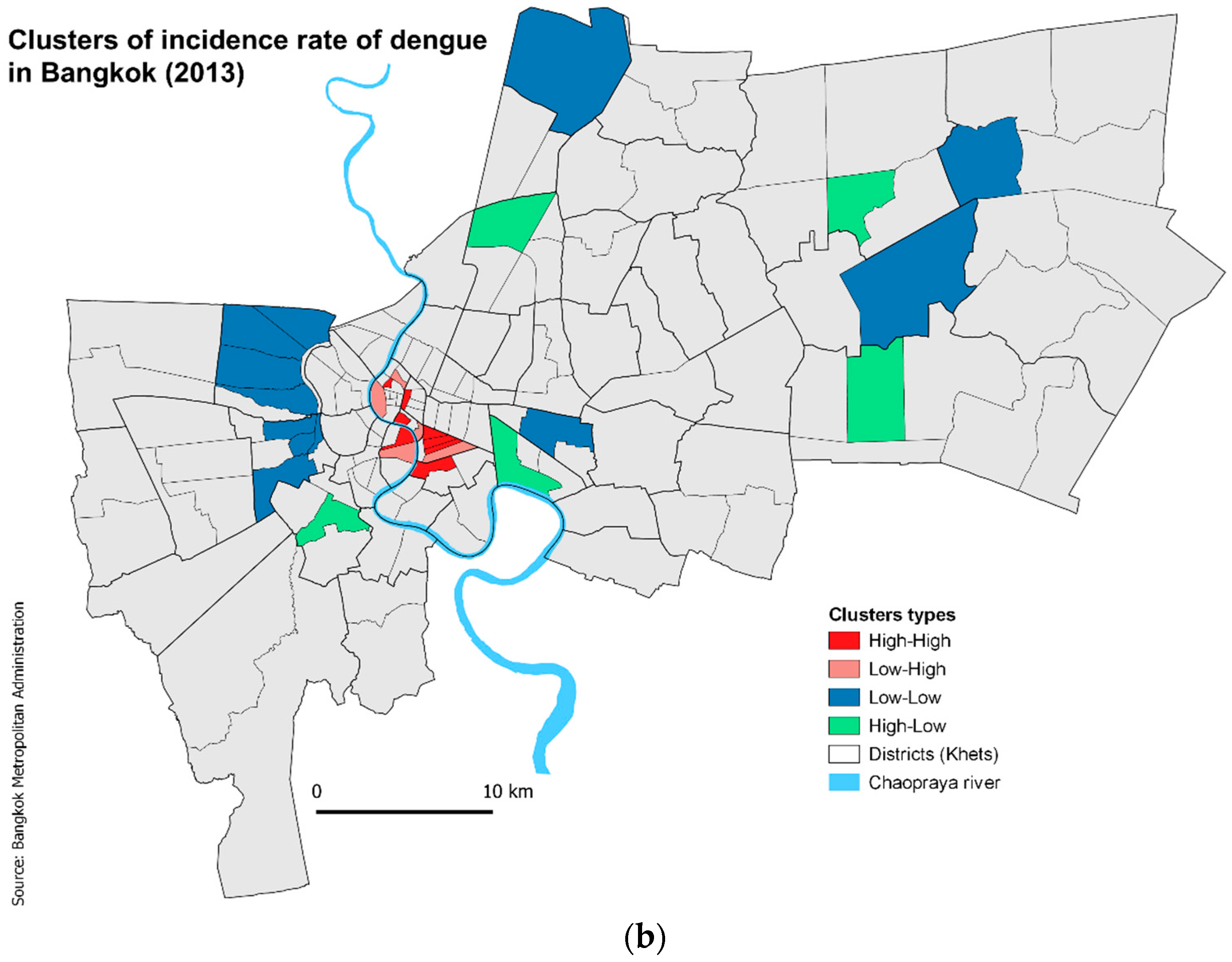

| Variables | aRR (95% CI) | p Value |
|---|---|---|
| Year | 1.03 (1.01–1.053) | 0.0043 |
| DTR (Lag 1 month) | 0.81 (0.74–0.90) | <0.001 |
| Maximum temperature | 0.92 (0.85–0.99) | 0.032 |
| Mean precipitation (Lag 1 month) | 1.05 (1.03–1.09) | <0.001 |
| Variable | Mean | SD |
|---|---|---|
| Demography | (%) or N | (%) |
| Age 0–4 years | 3.77 | 1.65 |
| Age 5–14 years | 9.22 | 2.97 |
| Age 15–24 years | 16.58 | 4.46 |
| Age 25–59 years | 59.17 | 4.62 |
| Age above 60 | 11.27 | 3.90 |
| Number of households (N 100s) | 179.3 | 186.3 |
| Area (km2) | 9.89 | 11.95 |
| Built-up Area (km2) | 0.38 | 0.40 |
| Dense vegetation area (km2) | 0.97 | 2.01 |
| Low vegetation area (km2) | 3.49 | 5.62 |
| Road area (km2) | 0.38 | 0.40 |
| Waterbody area (km2) | 0.81 | 3.89 |
| Population per household | 3.2 | 1.02 |
| Population density (km2) | 13,393 | 6324 |
| Education | ||
| No education | 4.82 | 2.17 |
| Primary | 16.94 | 9.02 |
| Secondary | 16.38 | 8.51 |
| Undergraduate | 26.01 | 10.12 |
| Postgraduate | 4.65 | 2.67 |
| Nationality | ||
| Immigrants | 9.96 | 8.02 |
| Types of occupation | ||
| Agriculture | 1.10 | 2.88 |
| Manual work | 21.66 | 10.60 |
| Household characteristics | ||
| Cement or brick houses | 74.99 | 14.76 |
| Wooden houses | 14.11 | 9.85 |
| Shop houses | 29.42 | 22.85 |
| Ground water | 0.05 | 0.10 |
| Rain water | 1.27 | 5.87 |
| Air conditioner | 46.21 | 13.89 |
| Pit toilet | 2.44 | 2.54 |
| Fixed Term | aRR | 95% Conf. Ints | Wald Statistic | p Value |
|---|---|---|---|---|
| %No education | 1.04 | 1.01–1.08 | 7.76 | 0.006 |
| % Cement houses | 1.006 | 1.002–1.01 | 6.95 | 0.009 |
| Nb houses (100s) | 1.0019 | 1.0015–1.0023 | 117.32 | <0.001 |
| lag 1 DTR | 0.61 | 0.58–0.63 | 772.07 | <0.001 |
| lag 1 Mean daily Rain | 1.051 | 1.045–1.058 | 319.12 | <0.001 |
| Year 2013 (vs. 2012) | 1.88 | 1.77–2.00 | 403.66 | <0.001 |
| Nb transport stops | 1.005 | 1.001–1.009 | 6.38 | 0.013 |
| Variables | LISA Cluster | 2012 | 2013 | ||||
|---|---|---|---|---|---|---|---|
| Mean | SE | p Value | Mean | SE | p Value | ||
| % No education | High–High | 7.40 | 0.67 | <0.001 | 8.16 | 0.86 | <0.001 |
| Low–Low | 4.22 | 0.47 | 0.300 | 4.18 | 0.79 | 0.310 | |
| Low–High | 6.21 | 0.69 | 0.092 | 5.89 | 1.06 | 0.170 | |
| High–Low | 4.77 | 0.75 | 0.806 | ||||
| No cluster | 4.61 | 0.18 | Ref | 4.64 | 0.17 | Ref | |
| %Cement house | High–High | 81.12 | 3.87 | 0.055 | 79.04 | 6.18 | 0.258 |
| Low–Low | 74.93 | 3.24 | 0.867 | 68.43 | 3.10 | 0.116 | |
| Low–High | 69.29 | 9.79 | 0.501 | 82.20 | 4.06 | 0.311 | |
| High–Low | 81.01 | 5.51 | 0.365 | ||||
| No cluster | 74.52 | 1.33 | Ref | 74.84 | 1.32 | Ref | |
| Nb houses (100s) | High–High | 34.29 | 6.88 | 0.007 | 40.86 | 10.98 | 0.023 |
| Low–Low | 316.26 | 57.88 | <0.001 | 164.45 | 58.04 | 0.593 | |
| Low–High | 49.42 | 16.12 | 0.165 | 44.37 | 13.73 | 0.076 | |
| High–Low | 185.53 | 59.30 | 0.918 | ||||
| No cluster | 173.12 | 14.58 | Ref | 194.17 | 16.77 | Ref | |
| Public Transport Stops Density | High–High | 16.32 | 2.12 | <0.001 | 22.51 | 1.44 | 0.001 |
| Low–Low | 4.20 | 0.63 | 0.237 | 7.74 | 0.89 | 0.032 | |
| Low–High | 17.11 | 2.63 | 0.001 | 25.83 | 2.16 | <0.001 | |
| High–Low | 8.42 | 2.63 | 0.255 | ||||
| No cluster | 6.00 | 0.64 | Ref | 6.50 | 0.63 | Ref | |
| Transport Matrix | Distance Matrix | |||
|---|---|---|---|---|
| w/o | with | w/o | with | |
| %No education | 0.047 2.2% | 0.081 36.9% | 0.047 2.1% | 0.072 73.1% |
| %Cement houses | 0.0035 11.5% | 0.0045 36.9% | 0.0034 10.8% | −0.027 0.03% |
| Nb houses (100s) | 0.0023 46.6% | 0.0023 18.9% | 0.002 48.1% | 0.0036 23.3% |
Publisher’s Note: MDPI stays neutral with regard to jurisdictional claims in published maps and institutional affiliations. |
© 2022 by the authors. Licensee MDPI, Basel, Switzerland. This article is an open access article distributed under the terms and conditions of the Creative Commons Attribution (CC BY) license (https://creativecommons.org/licenses/by/4.0/).
Share and Cite
Lefebvre, B.; Karki, R.; Misslin, R.; Nakhapakorn, K.; Daudé, E.; Paul, R.E. Importance of Public Transport Networks for Reconciling the Spatial Distribution of Dengue and the Association of Socio-Economic Factors with Dengue Risk in Bangkok, Thailand. Int. J. Environ. Res. Public Health 2022, 19, 10123. https://doi.org/10.3390/ijerph191610123
Lefebvre B, Karki R, Misslin R, Nakhapakorn K, Daudé E, Paul RE. Importance of Public Transport Networks for Reconciling the Spatial Distribution of Dengue and the Association of Socio-Economic Factors with Dengue Risk in Bangkok, Thailand. International Journal of Environmental Research and Public Health. 2022; 19(16):10123. https://doi.org/10.3390/ijerph191610123
Chicago/Turabian StyleLefebvre, Bertrand, Rojina Karki, Renaud Misslin, Kanchana Nakhapakorn, Eric Daudé, and Richard E. Paul. 2022. "Importance of Public Transport Networks for Reconciling the Spatial Distribution of Dengue and the Association of Socio-Economic Factors with Dengue Risk in Bangkok, Thailand" International Journal of Environmental Research and Public Health 19, no. 16: 10123. https://doi.org/10.3390/ijerph191610123
APA StyleLefebvre, B., Karki, R., Misslin, R., Nakhapakorn, K., Daudé, E., & Paul, R. E. (2022). Importance of Public Transport Networks for Reconciling the Spatial Distribution of Dengue and the Association of Socio-Economic Factors with Dengue Risk in Bangkok, Thailand. International Journal of Environmental Research and Public Health, 19(16), 10123. https://doi.org/10.3390/ijerph191610123







